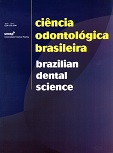Avaliação da técnica de utilização da matriz/cunha na microinfiltração de restaurações de resina composta em dentes posteriores
DOI:
https://doi.org/10.14295/bds.2006.v9i3.207Abstract
O objetivo deste estudo foi avaliar a técnica de utilização da matriz/cunha na microinfiltração de restaurações de resina composta em dentes posteriores, utilizando dois sistemas adesivos. Foram realizados 40 preparos, Classe II, em 20 molares hígidos, sendo que em cada dente foram realizadas duas cavidades, uma na face distal e outra na face mesial. No Grupo I, foi utilizado Single Bond/Filtek Supreme (3M Dental Products, St Paul, MN, USA) e a colocação da matriz/cunha foi antes do procedimento adesivo. No grupo II, os procedimentos foram semelhantes ao grupo I, exceto a colocação da matriz/cunha que foi depois do procedimento adesivo. No grupo III, foi utilizado Scotchbond Multi-Uso/P 60 (3M Dental Products, St Paul, MN, USA) e a colocação da matriz/cunha foi antes do procedimento adesivo. No grupo IV, os procedimentos foram semelhantes ao grupo III, exceto a colocação da matriz/cunha que foi depois do procedimento adesivo. Os dentes foram submetidos à ciclagem térmica (500 ciclos, entre 5°C e 55°C), impermeabilizados com esmalte de unha e seccionados no sentido mesio-distal. As secções foram avaliadas pelo grau de infiltração do corante (fucsina básica 0.5%). Após a realização do teste de Kruskal-Wallis, observou-se que não houve diferença entre os grupos (p=0,33). A seguir, compararam-se os dados por sistema de união utilizado, unindo os grupos I e II (SB) e III e IV (SBMP), pelo teste U de Mann-Whitney e, também, não apresentou diferença significativa (p=0,071). Conclui-se que o momento da inserção da matriz/cunha não interferiu no grau de microinfiltração das restaurações de resina composta em dentes posteriores.
Downloads
Downloads
Published
How to Cite
Issue
Section
License
Brazilian Dental Science uses the Creative Commons (CC-BY 4.0) license, thus preserving the integrity of articles in an open access environment. The journal allows the author to retain publishing rights without restrictions.
=================




























